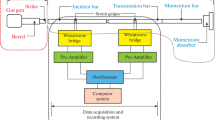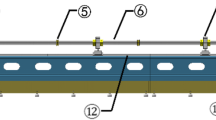Abstract
The dynamic behaviour of different materials has been widely studied using the split Hopkinson pressure bar (SHPB) testing. The striker bar's velocity (SV) and the incident bar's impact surface are well known to have a significant impact on producing a clear signal in the compressive SHPB studies. Several times, the shape of the incident strain signal differs from an ideal state, and the reason is difficult to find. In this paper, a parametric investigation of such understudied instances is carried out utilising Abaqus software for finite element analysis (FEA). The numerically obtained incident strain pulse for a perfectly aligned SHPB setup with different SV was validated experimentally on compressive SHPB apparatus. The numerical output was found to have good agreement with experimental results. Further, plots of incident strain were evaluated numerically for Sv (10, 15, 20, 25 and 30 in m/s) which was used for polynomial fitting using MATLAB's curve fitting tool. A similar method was adopted for symmetrically plane non-parallel impact surface on the incident bar. The angles chosen for FEA calculations were 5°, 10°, 15° and 20°. Filleted impact surface with radius (r) 1.5, 3, 4.5 and 6 mm was also studied. The study of the variation of impact surface shape was done at a striker velocity of 25 m/s. It was observed from this study that when striker velocity increases, the absolute magnitude of incident strain at peak increases while rise time remained constant. In turn, when the symmetrically non-parallel plane surface angle and fillet radius grow, the absolute value of incident strain at peak almost stays the same but the rising time lengthens. This study can help understand the nature and discrepancy of the incident strain signal obtained in the compressive SHPB setup and find its root cause.















Similar content being viewed by others
References
R. Gümrük, R.A.W. Mines, and S. Karadeniz, Determination of Strain Rate Sensitivity of Micro-Struts Manufactured Using the Selective Laser Melting Method, J. Mater. Eng. Perform., 2018, 27(3), p 1016–1032.
Shubham, C.S. Yerramalli, C. Sumant, R.K. Prusty, and B.C. Ray, Finite Element Modelling and Experimentation of Plain Weave Glass/Epoxy Composites under High Strain-Rate Compression Loading for Estimation of Johnson-Cook Model Parameters, Int. J. Impact Eng., 2022, 167, p 104262.
Shubham, C.S. Yerramalli, R.K. Prusty, and B.C. Ray, Through-Thickness High Strain Rate Compressive Response of Glass/Epoxy-Laminated Composites Embedded with Randomly Oriented Discontinuous Carbon Fibers, Advances in Structural Integrity. K. Jonnalagadda, A. Alankar, N.J. Balila, T. Bhandakkar Ed., Springer, Singapore, 2022, p 103–111.
M.E. Korkmaz, P. Verleysen, and M. Günay, Identification of Constitutive Model Parameters for Nimonic 80A Superalloy, Trans. Indian Inst. Met., 2018, 71(12), p 2945–2952.
W. Tang, S. Kang, and Z. Liu, Dynamic Compression Deformation and Constitutive Model of Extruded Mg–1Zn–2Y Bar, Trans. Indian Inst. Met., 2021 https://doi.org/10.1007/s12666-021-02372-w
D.J. Frew, M.J. Forrestal, and W. Chen, A Split Hopkinson Pressure Bar Technique to Determine Compressive Stress-Strain Data for Rock Materials, Exp. Mech., 2001, 41(1), p 40–46.
U.S. Lindholm, Some Experiments with the Split Hopkinson Pressure Bar*, J. Mech. Phys. Solids, 1964, 12(5), p 317–335.
M.J. Forrestal, T.W. Wright, and W. Chen, The Effect of Radial Inertia on Brittle Samples during the Split Hopkinson Pressure Bar Test, Int. J. Impact Eng., 2007, 34(3), p 405–411.
R. Edwin Raj, V. Parameswaran, and B.S.S. Daniel, Comparison of Quasi-Static and Dynamic Compression Behavior of Closed-Cell Aluminum Foam, Mater. Sci. Eng. A, 2009, 526(1), p 11–15.
S. Sharma and M.K. Samal, Experimental Investigation of Strain-Rate- and Temperature-Dependent Mechanical Properties of SA516Gr.70 Steel and Development of an Appropriate Material Model, J. Mater. Eng. Perform., 2021, 30(1), p 116–130.
M.K. Samal and S. Sharma, A New Procedure to Evaluate Parameters of Johnson-Cook Elastic–Plastic Material Model from Varying Strain Rate Split Hopkinson Pressure Bar Tests, J. Mater. Eng. Perform., 2021, 30(11), p 8500–8514.
J. Malachowski, P. Baranowski, R. Gieleta, D. Koodziejczyk, K. Damaziak, and Ł Mazurkiewicz, Numerical Study for Determination of Pulse Sha** Desing Variables in SHPB Apparatus, Bull. Pol. Acad. Sci. Tech. Sci., 2013, 61, p 459–466.
D.J. Frew, M.J. Forrestal, and W. Chen, Pulse Sha** Techniques for Testing Elastic-Plastic Materials with a Split Hopkinson Pressure Bar, Exp. Mech., 2005, 45(2), p 186.
A. Bagher Shemirani, R. Naghdabadi, and M.J. Ashrafi, Experimental and Numerical Study on Choosing Proper Pulse Shapers for Testing Concrete Specimens by Split Hopkinson Pressure Bar Apparatus, Constr. Build. Mater., 2016, 125, p 326–336.
D. Mohr, G. Gary, and B. Lundberg, Evaluation of Stress-Strain Curve Estimates in Dynamic Experiments, Int. J. Impact Eng., 2010, 37(2), p 161–169.
J.M. Lifshitz, and H. Leber, Data Processing in the Split Hopkinson Pressure Bar Tests, Int. J. Impact Eng., 1994, 15(6), p 723–733.
H. Zhao and G. Gary, On the Use of SHPB Techniques to Determine the Dynamic Behavior of Materials in the Range of Small Strains, Int. J. Solids Struct., 1996, 33(23), p 3363–3375.
Z. Li and J. Lambros, Determination of the Dynamic Response of Brittle Composites by the Use of the Split Hopkinson Pressure Bar, Compos. Sci. Technol., 1999, 59(7), p 1097–1107.
T. Vuoristo and V.-T. Kuokkala, Creep, Recovery and High Strain Rate Response of Soft Roll Cover Materials, Mech. Mater., 2002, 34(8), p 493–504.
G. Larbi, T. Mostapha, O. Hocine, and A. El Malki Alaoui, A Practical Note for SHPB Test with New Algorithms for Delimiting Pulses, Compos. Struct., 2015, 126, p 145–158.
G.T. Gray, Classic Split-Hopkinson Pressure Bar Testing, Mechanical Testing and Evaluation. H. Kuhn, D. Medlin Ed., ASM International, 2000, p 462–476. https://doi.org/10.31399/asm.hb.v08.a0003296
M.A. Kariem, J.H. Beynon, and D. Ruan, Misalignment Effect in the Split Hopkinson Pressure Bar Technique, Int. J. Impact Eng., 2012, 47, p 60–70.
B. Song, K. Connelly, J. Korellis, W.-Y. Lu, and B.R. Antoun, Improved Kolsky-Bar Design for Mechanical Characterization of Materials at High Strain Rates, Meas. Sci. Technol., 2009, 20(11), p 115701.
“Curve Fitting Toolbox Documentation, https://www.mathworks.com/help/curvefit/. Accessed 14 September 2021.
N.K. Naik and V.R. Kavala, High Strain Rate Behavior of Woven Fabric Composites under Compressive Loading, Mater. Sci. Eng. A, 2008, 474(1), p 301–311.
K.S. Pandya, C.H. Veerraju, and N.K. Naik, Hybrid Composites Made of Carbon and Glass Woven Fabrics under Quasi-Static Loading, Mater. Des., 2011, 32(7), p 4094–4099.
Shubham, R.K. Prusty, and B.C. Ray, High Strain-Rate Through-Thickness Compression Testing of Symmetrical Inter-Ply Hybrid Polymer Composites Reinforced with Carbon/Glass and Carbon/Kevlar Fibers, Trans. Indian Inst. Met., 2022, 25, p 5. https://doi.org/10.1007/s12666-022-02619-0
X. Wu, Q. Yin, Y. Wei, and C. Huang, Effects of Imperfect Experimental Conditions on Stress Waves in SHPB Experiments, Acta Mech. Sin., 2015, 31(6), p 827–836.
Acknowledgments
The authors are obliged to the National Institute of Technology Rourkela, India, and the Indian Institute of Technology Bombay, India, for providing infrastructural backing for this study. The guidance provided by Prof. Chandra Sekher Yerramalli is deeply acknowledged. Mr. Chinmay Sumant and Mr. Rajesh Patnaik's technical support was also very much appreciated.
Author information
Authors and Affiliations
Corresponding author
Additional information
Publisher's Note
Springer Nature remains neutral with regard to jurisdictional claims in published maps and institutional affiliations.
Rights and permissions
Springer Nature or its licensor (e.g. a society or other partner) holds exclusive rights to this article under a publishing agreement with the author(s) or other rightsholder(s); author self-archiving of the accepted manuscript version of this article is solely governed by the terms of such publishing agreement and applicable law.
About this article
Cite this article
Shubham, Prusty, R.K. & Ray, B.C. Incident Strain Pulse Sensitivity in Split Hopkinson Pressure Bar Testing Setup for Variable Conditions: A Numerical and Statistical Approach. J. of Materi Eng and Perform 33, 463–474 (2024). https://doi.org/10.1007/s11665-023-07963-w
Received:
Revised:
Accepted:
Published:
Issue Date:
DOI: https://doi.org/10.1007/s11665-023-07963-w




